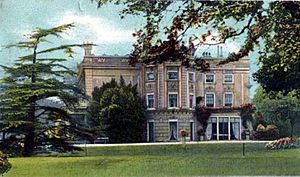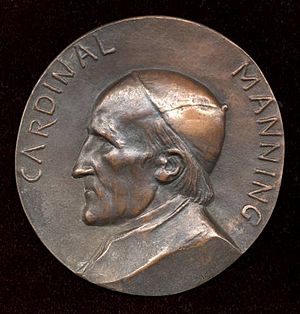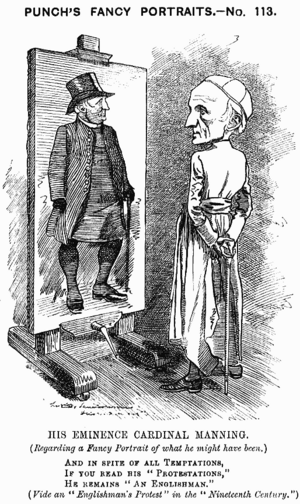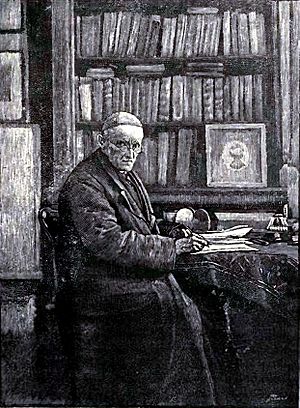Henry Edward Manning facts for kids
Quick facts for kids His Eminence Henry Edward Manning |
|
|---|---|
| Cardinal, Archbishop of Westminster Primate of England and Wales |
|
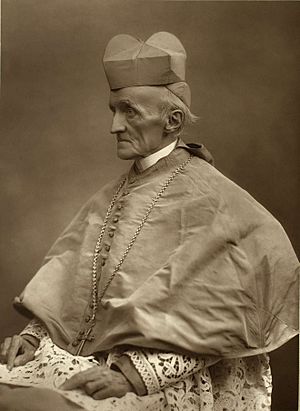
Cardinal Manning, c. 1880s
|
|
| Church | Latin Church |
| Province | Westminster |
| Diocese | Westminster |
| Appointed | 16 May 1865 |
| Reign ended | 14 January 1892 |
| Predecessor | Nicholas Wiseman |
| Successor | Herbert Vaughan |
| Other posts | Cardinal-Priest of Santi Andrea e Gregorio al Monte Celio |
| Orders | |
| Ordination | 23 December 1833 (Anglican priest) 14 June 1851 (Catholic priest) |
| Consecration | 8 June 1865 by William Bernard Ullathorne |
| Created Cardinal | 15 March 1875 |
| Rank | Cardinal-Priest |
| Personal details | |
| Born | 15 July 1808 Totteridge, Hertfordshire, England |
| Died | 14 January 1892 (aged 83) London, England |
| Buried | Westminster Cathedral |
| Nationality | British |
| Denomination | Catholicism (formerly Anglicanism) |
| Parents | William and Mary (née Hunter) Manning |
| Spouse |
Caroline Sargent
(m. 1833; died 1837) |
| Previous post |
|
Henry Edward Manning (born July 15, 1808 – died January 14, 1892) was an important English leader in the Catholic Church. He served as the second Archbishop of Westminster from 1865 until he passed away in 1892. Manning first became a priest in the Church of England. However, he later decided to become a Catholic after a major legal decision called the Gorham judgement.
Contents
Early Life and Education
Henry Edward Manning was born on July 15, 1808. His birthplace was Copped Hall, Totteridge, in Hertfordshire, England. He was the youngest of three sons. His father, William Manning, was a successful merchant and a well-known politician. He even served in the British Parliament for 30 years. Henry's mother was Mary Hunter.
Henry spent his childhood at Coombe Bank in Kent. He went to Harrow School from 1822 to 1827. While there, he played cricket for two years. After Harrow, he attended Balliol College, Oxford, starting in 1827. He studied Classics and became a skilled debater at the Oxford Union. He even became its president in 1830.
At first, Manning wanted a career in politics. But his father faced financial difficulties. So, after graduating with top honors in 1830, Henry took a job at the Colonial Office. He left this job in 1832. Around this time, he felt a strong calling to become a priest.
Becoming an Anglican Priest
In 1832, Henry Manning returned to Oxford. He was chosen as a fellow at Merton College. Soon after, he became a deacon in the Church of England. In January 1833, he started working as a curate (a junior priest) in West Sussex. After the rector (head priest) passed away, Manning took over as rector in May 1833.
Manning married Caroline Sargent on November 7, 1833. She was the daughter of the previous rector. Sadly, their marriage was short. Caroline came from a family with health issues and died childless on July 24, 1837. Many years later, after Manning died as a Catholic priest, a locket with his wife's picture was found around his neck.
Manning's religious beliefs became more traditional over time. He was influenced by John Henry Newman, another important religious leader. Manning publicly supported the Tractarian movement. This group wanted to bring back older Christian traditions within the Church of England.
In 1838, Manning played a big part in a movement to improve church education. He also visited Rome for the first time that year. In 1841, he became the Archdeacon of Chichester. This meant he was responsible for overseeing many parishes. He visited every parish in his area by 1843.
Manning was known as a powerful speaker. He published a book called The Unity of the Church in 1842. He also gave sermons at Oxford University. Four collections of his sermons were published between 1842 and 1850.
Choosing Catholicism
Manning's faith in the Church of England was deeply shaken in 1850. This happened because of a legal case known as the Gorham judgement. In this case, a court ordered the Church of England to accept a priest who did not believe that baptism had a real spiritual effect.
For Manning and many others, this was a serious problem. They believed it went against the clear teachings of the Christian Church. The fact that a non-religious court could force the Church of England to accept such a view made Manning believe that the church was not truly a divine institution. He felt it was controlled by the English government.
Because of this, Manning decided to become a Catholic. On April 6, 1851, he officially joined the Catholic Church. He then studied in Rome and earned a doctorate. On June 14, 1851, he became a Catholic priest. Because of his great skills and reputation, he quickly became an influential figure.
In 1857, Manning helped set up a new church mission in London. He also founded a new group of priests called the Congregation of the Oblates of St. Charles. This community was created to serve the needs of the Catholic Church in Westminster. Manning became the leader of this new group.
Becoming Archbishop and Cardinal
In 1865, Henry Edward Manning was appointed Archbishop of Westminster. This made him the head of the Catholic Church in England.
As Archbishop, he achieved many things. He helped acquire the land for the future Westminster Cathedral. He also worked hard to expand Catholic education. He even helped establish a short-lived Catholic University College in Kensington.
In 1875, Manning was given the title of Cardinal-Priest. This is a very high rank in the Catholic Church. He participated in the meeting (called a conclave) that elected Pope Leo XIII in 1878. Manning also approved the creation of the Catholic Association Pilgrimage.
Working for Social Justice
Cardinal Manning played a very important role in shaping the modern Catholic Church's views on social justice. He had a good relationship with Pope Pius IX. His strong belief in the Pope's authority (called ultramontane views) earned him the trust of the Vatican.
Manning used his influence to promote new Catholic ideas about fairness and justice in society. These ideas later appeared in an important letter from Pope Leo XIII called Rerum novarum. This letter marked the beginning of modern Catholic social justice teaching.
In 1870, Manning attended the First Vatican Council in Rome. He was a strong supporter of the idea of papal infallibility. This doctrine states that the Pope cannot make a mistake when speaking officially on matters of faith and morals.
In 1888, Manning helped settle a major workers' strike in London, the London dock strike of 1889. He was asked to help by a social activist named Margaret Harkness. He also influenced many people to convert to Catholicism, including Elizabeth Belloc, the mother of a famous British author. However, Manning did not support women getting the right to vote. He believed women should focus on their private lives.
His View of the Priesthood
In 1883, Manning published his most famous book, The Eternal Priesthood. In this book, he wrote about the high importance of being a priest. He believed that the priesthood was a special path to spiritual perfection.
Manning argued that priests had a very serious moral duty. He also emphasized that priests should do more than just perform religious ceremonies. They should be active members of their communities and serve the people.
Death and Burial
Henry Edward Manning passed away on January 14, 1892. He was first buried at St Mary's Roman Catholic Cemetery in Kensal Green. Later, in 1907, his remains were moved to the newly finished Westminster Cathedral.
Works
- Rule of Faith (1839)
- Unity of the Church (1842)
- A charge delivered at the ordinary visitation of the archdeaconry of Chichester in July (1843)
- Sermons 4 vols. (1842–1850)
- The Present Crisis of the Holy See (1861)
- Rome and the Revolution (1867)
- Christ and Antichrist (1867)
- Petri Privilegium (1871)
- The Glories of the Sacred Heart (1876)
- The True Story of the Vatican Council (1877)
- The Eternal Priesthood (1883)
- The Little Flowers of Saint Francis (Manning's translation from the Italian published 1894)
See also
 In Spanish: Henry Edward Manning para niños
In Spanish: Henry Edward Manning para niños


